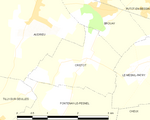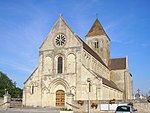The Battle of Le Mesnil-Patry during the Second World War, was the last attack by an armoured battle group conducted by Canadian troops in Normandy in June 1944. The Queen's Own Rifles of Canada of the 8th Canadian Infantry Brigade of the 3rd Canadian Division, supported by the 6th Armoured Regiment (1st Hussars) of the 2nd Canadian Armoured Brigade attacked the village of Le Mesnil-Patry in Normandy, to advance southwards towards the higher ground of Hill 107 to the west of Cheux. The attack was intended to support a larger operation by the 50th (Northumbrian) Infantry Division and the 7th Armoured Division to capture the city of Caen and to advance in the centre of the bridgehead next to the First US Army. The battle was a German defensive success but the greater German objective of defeating the invasion by a counter-offensive also failed.
Both sides changed tactics after the first week of the invasion, the Germans constructed a defence-in-depth, with tank forces reserved for limited counter-attacks, intended to slow the Allied advance inland and avoid casualties and losses of equipment until reinforcements arrived. The Allies began to accumulate supplies to conduct attrition attacks, rather than persist with mobile operations by large numbers of tanks supported by infantry. More atrocities by troops of the 12th SS-Panzer Division Hitlerjugend against Canadian prisoners occurred and orders given by a junior Canadian commander to refrain from taking German prisoners as a reprisal, were countermanded by higher authority as soon as they were discovered. Canadian offensive operations in the 3rd Canadian Infantry Division area ceased, apart from raiding and reconnaissance patrols, until VIII Corps commenced Operation Epsom on 26 June.












